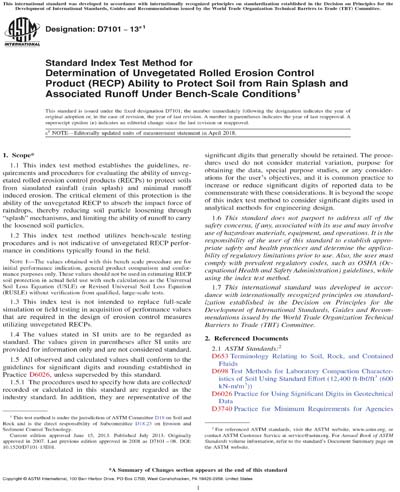Historical
ASTM D7101-13e1
Standard Index Test Method for Determination of Unvegetated Rolled Erosion Control Product (RECP) Ability to Protect Soil from Rain Splash and Associated Runoff Under Bench-Scale Conditions
1.1 This index test method establishes the guidelines, requirements and procedures for evaluating the ability of unvegetated rolled erosion control products (RECPs) to protect soils from simulated rainfall (rain splash) and minimal runoff induced erosion. The critical element of this protection is the ability of the unvegetated RECP to absorb the impact force of raindrops, thereby reducing soil particle loosening through “splash” mechanisms, and limiting the ability of runoff to carry the loosened soil particles.
1.2 This index test method utilizes bench-scale testing procedures and is not indicative of unvegetated RECP performance in conditions typically found in the field.
Note 1: The values obtained with this bench scale procedure are for initial performance indication, general product comparison and conformance purposes only. These values should not be used in estimating RECP soil protection in actual field use with such calculations as the Universal Soil Loss Equation (USLE) or Revised Universal Soil Loss Equation (RUSLE) without verification from qualified, large-scale tests.
1.3 This index test is not intended to replace full-scale simulation or field testing in acquisition of performance values that are required in the design of erosion control measures utilizing unvegetated RECPs.
1.4 The values stated in SI units are to be regarded as standard. The values given in parentheses after SI units are provided for information only and are not considered standard.
1.5 All observed and calculated values shall conform to the guidelines for significant digits and rounding established in Practice D6026, unless superseded by this standard.
1.5.1 The procedures used to specify how data are collected/recorded or calculated in this standard are regarded as the industry standard. In addition, they are representative of the significant digits that generally should be retained. The procedures used do not consider material variation, purpose for obtaining the data, special purpose studies, or any considerations for the user’s objectives, and it is common practice to increase or reduce significant digits of reported data to be commensurate with these considerations. It is beyond the scope of this index test method to consider significant digits used in analytical methods for engineering design.
1.6 This standard does not purport to address all of the safety concerns, if any, associated with its use and may involve use of hazardous materials, equipment, and operations. It is the responsibility of the user of this standard to establish appropriate safety and health practices and determine the applicability of regulatory limitations prior to use. Also, the user must comply with prevalent regulatory codes, such as OSHA (Occupational Health and Safety Administration) guidelines, while using the index test method.
1.7 This international standard was developed in accordance with internationally recognized principles on standardization established in the Decision on Principles for the Development of International Standards, Guides and Recommendations issued by the World Trade Organization Technical Barriers to Trade (TBT) Committee.
Content Provider
ASTM International [astm]






